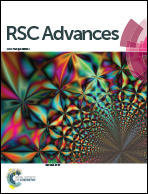In situ formation of 2-thiobarbituric acid incorporated g-C3N4 for enhanced visible-light-driven photocatalytic performance†
Abstract
Embedding heterocycles into the skeleton of g-C3N4 has been proved to be a simple and efficient strategy for improving light response and the separation of photo-excited charges. Herein, 2-thiobarbituric acid incorporated g-C3N4 (TBA/CN) with good photocatalytic efficiency for Rh B degradation and H2 production was successfully achieved via a facile thermal copolymerization approach. The incorporation of aromatics and S atoms into the skeleton of g-C3N4 was identified via systematic characterizations. This unique structure contributed to the narrowed band-gap, extended delocalization of lone pair electrons and changed electron transition pathway, which led to the enhanced visible light utilization, accelerated charge migration and prolonged electron lifetime, subsequently resulting in the significant boost of photocatalytic activity. The optimal TBA/CN-3 sample yielded the largest Rh B degradation rate constant k value of 0.0273 min−1 and simultaneously highest rate of H2 evolution of 0.438 mmol g−1 h−1, which were almost 3.5 and 3.8 folds as fast as that of the pristine CN, respectively. Finally, the photocatalytic mechanism was proposed for the detailed elucidation of the process of Rh B degradation coupled with H2 production.



 Please wait while we load your content...
Please wait while we load your content...